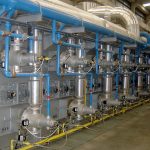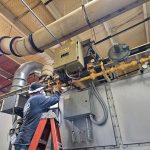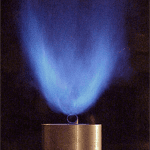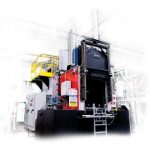Furnace Maintenance
When a heat treat manager or anyone responsible for purchasing heat treating equipment makes a buy decision, they must first consider the process required,...
Q&A with Diane Haggerty
What makes PowderMet2023 and AMPM2023 important events within the industry?
As the premier powder metallurgy (PM) events in the Americas, the annual PowderMet (International Conference...
Q&A with Susan Heinauer
Thermal Processing welcomes its newest sales representative to its staff, Susan Heinauer. She has more than 20 years of experience in sales and promises...
Remembering where we came from
In this fast-paced world, it gets harder and harder to remember the past. It seems like the only thing that matters is this quarter....
Q&A with Guido Locatelli
Tell us about your company.
The company was established in 1984 near Milan, Italy, in the city of Caravaggio, and since its inception the headquarters...
Gear inspection methods from heat-treat simulation
Gear design is a complex process, involving dozens of parameters, tolerances, and relationships to mating components. Generally, professional standards guide the gear designer to...
Q&A with Tom Morrison
When did you make the decision to take FNA virtual?
Our Executive Committee has been meeting weekly since April when COVID-19 really started to take...
Heat Treating, Furnaces, and Unintended Consequences
A few decades ago, my involvement with depleted uranium (DU) began in the metallurgical R&D department, developing program logic to heat treat DU in...
Spotlight on IHEA member Bloom Engineering
Bloom Engineering began at a shop in Pittsburgh’s North Side in 1934 and eventually moved to its current site in 1962. The company is...
Atmosphere furnace control
Proper temperature is crucial to part quality, but don’t overlook its effect on atmosphere control
2019 annual meeting marks its 90th year
The Industrial Heating Equipment Association will celebrate its 90th anniversary at the 2019 Annual Meeting, April 29-May 1 at Lido Beach Resort in Sarasota,...
The State of Process Controls
It is hard to find a market segment that has not benefited from technology advancements. Heat-treating process control is no different. While there are...
Variation in steel hardenability
Many heat-treating processes cannot tolerate appreciable variations in steel hardenability. For an established in-control process, deviations in chemical composition and starting microstructure may result...
Employers need to expand on carrot-stick philosophy
We all trade time for money. Gone are the days of bartering, trading your chickens for goats. We go to work to earn a...
Q&A with James P. Adams
PowderMet2024, in Pittsburgh, Pennsylvania, June 16-19, will be a hub of technology transfer for professionals from every part of the powder metallurgy and metal...
Compelling reasons normalizing produces high quality gears
In this day and age, adding steps to the gear manufacturing process is not highly desirable unless the benefits far outweigh the costs incurred....
Heat treatment of aluminum, part II: Water quenching
In the last article, we talked about the metallurgy behind quenching aluminum. Now we are going to discuss the available quenchants for aluminum.
Introduction
To achieve...
Q&A with David Strand
President and CEO, Wisconsin Oven Corporation and Thermal Product Solutions
Q&A with Lauren Jones
Why is it important to invest in the future of heat-treating?
Nearly every metal component undergoes some type of heat-treating application. Vacuum furnaces contribute to...
Future of heat treating of gears is similar to garage sale mentality
When and how does a heat treater determine whether to purchase new equipment or rebuild an old furnace?
Several years ago I participated in a...
Why is modeling the immersion process so important?
Liquid quenching of long steel components can introduce significant distortion if the component is not lowered into the liquid quench bath properly. Whether the...
Coupling Alloy and Process Selection
Combining both alloying and processing into a single strategy to achieve a desired level of performance sounds like a simple concept, but can be...
IHEA offers hands-on training in Atlanta
The Industrial Heating Equipment Association (IHEA), the Chemical Coaters Association International (CCAI), Products Finishing magazine, and Southern Company have teamed up to provide a...
Heat treatment of aluminum Part VII – Hardness and conductivity
In the previous article, we discussed the artificial aging of aluminum. Once we have heat treated the parts, we need to verify the properties....
Quality and production are a team, not adversaries
Let me be honest about the elephant in the room that often exists in heat treating. In some cases, but certainly not all, quality...
Determining Grossman H-value from cooling curve data
In the last article, I described how the Jominy end quench test could be used to predict hardness for a series of different round...
Q&A with Trevor Jones
Solar Manufacturing recently received a patent (#11,815,403) for an improved vacuum furnace control thermocouple design. What makes this improved design important?
Solar Manufacturing and Solar...
Carbon Diffusion and Carburizing Parameter Selection
Although carburizing is a complicated process, it can be broken down into two main steps: carbon generation in the furnace and carbon diffusion into...
Thermal expansion of mineral oil quenchants
In this column, I will discuss the thermal expansion of oil. This information is primarily important for initial fills of a quench tank.
Introduction
Oil, when...
Q&A with Jeff Marshall
What does MHV do for the heat-treat industry?
We make our customers more competitive, which is good both for the customers and for the industry...
Simulation tools to effectively calculate process
One common goal for a wide range of industries has been to increase power density in shaft and gear components. The steel producing industry...
Quality of leadership matters – at all employee levels
Leadership isn’t always about the top management directing the way for the company. Leadership can be found at all levels of the company in...
Member spotlight TEECO: Knowledgeable support, timely service for industrial combustion systems
Thermal Energy Engineering Company (TEECO) is a service company focused on supporting industrial combustion systems across numerous disciplines. Whether it’s baking cheesecakes, melting metals,...
IHEA educates the industry in person, online
Looking ahead … Register now!
Fundamentals of Industrial Process Heating
Winter Online Course
January 25–March 7, 2021
IHEA’s Fundamentals of Industrial Process Heating Online Learning Course has been...
ITPS delivers outstanding presentations to industry executives
Industry leaders and executives gathered in Atlanta July 30-August 1 for the second ITPS — International ThermProcess Summit — and by all accounts and...
Q&A with Dennis Beauchesne
When was vacuum carburizing introduced?
The process has been around since the 1960s. Vacuum carburizing enables more precise control of case depth and microstructure than...
IHEA’s 2020 fall combustion and safety seminars go virtual
Each fall, the Industrial Heating Equipment Association (IHEA) brings industrial process heating professionals together to provide combustion and safety education for the industry. This...
Maximize downtime for large repairs
When your furnace is down for large repairs, use the opportunity to catch up on overdue or extensive maintenance
Furnace atmospheres and temperature
Getting the Right Protective and Carburizing Atmosphere
The makeup of a furnace’s atmosphere in the heat treating process varies based upon the application. For carburizing,...





















































